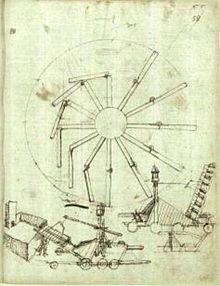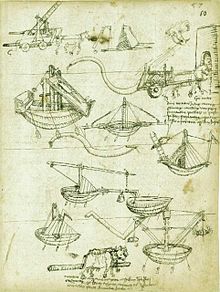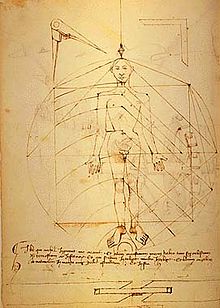- Taccola
-
Mariano di Jacopo detto il Taccola (1382 – c. 1453), called Taccola ('Crow'), was an Italian administrator, artist and engineer of the early Renaissance. Taccola is known for his technological treatises De ingeneis and De machinis, which feature annotated drawings of a wide array of innovative machines and devices. Taccola’s work was widely studied and copied by later Renaissance engineers and artists, among them Francesco di Giorgio, and perhaps even Leonardo da Vinci.
Contents
Life and career
Mariano Taccola was born in Siena in 1382. Practically nothing is known of his early years of training or apprenticeship.[2] As an adult, he pursued a varied career in Siena, working in such diverse jobs as notary, university secretary, sculptor, superintendent of roads and hydraulic engineer.[3] In the 1440s, Taccola retired from his official positions, receiving a pension from the state. He is known to have joined the fraternal order of San Jacomo by 1453 and presumably died around that date.[4]
Work and style
Taccola left behind two treatises, the first being De ingeneis (Concerning engines), work on its four books starting as early as 1419.[5] Having been completed in 1433, Taccola continued to amend drawings and annotations to De ingeneis until about 1449. In the same year, Taccola published his second manuscript, De machinis (Concerning machines), in which he restated many of the devices from the long development process of his first treatise.
Drawn with black ink on paper and accompanied by hand-written annotations, Taccola depicts in his work a multitude of 'ingenious devices' in hydraulic engineering, milling, construction and war machinery. Taccola’s drawings show him to be a man of transition: While his subject matter is already that of later Renaissance artist-engineers, his method of representation still owes much to medieval manuscript illustration.[6] Notably, with perspective coming and going in his drawings, Taccola seemed to remain largely unaware of the ongoing revolution in perspective painting.[7] This is the more curious, since he is the only man known to have interviewed the 'father of linear perspectivity' himself, Filippo Brunelleschi.[4] Despite these graphic inconsistencies, Taccola’s style has been described as being forceful, authentic and usually to be relied upon to capture the essential.[8]
Influence and rediscovery
Being named as the 'Sienese Archimedes', Taccola’s work stands at the beginning of the tradition of Italian Renaissance artist-engineers, with a growing interest in technological matters of all kinds. Taccola’s drawings were copied and served as source of inspiration by such as Buonacorso Ghiberti, Francesco di Giorgio, and perhaps even Leonardo da Vinci.[4] Special historical importance hold his drawings of the ingenious lifting devices and reversible-gear systems which Brunelleschi devised for the construction of the dome of the Florence cathedral,[9] at the time the second widest in the world.
Taccola is also known for pioneering the keel breaker, a lever-based device designed to tear holes in the hull (keel) of a ship using its fork or spike.[10] Primarily used against pirates, though supposedly used by Mediterranean navies.[citation needed]
Interest in Taccola’s work, however, practically ceased some time after his death until quite recently,[2] one reason perhaps being that his treatises only ever circulated as handcopied books, with at least three of them remaining extant today.[11] Taccola’s original manuscripts, whose style turned out to be more sophisticated than those of its copies, were rediscovered and identified in the state libraries of Munich and Florence only in the 1960s, giving impetus for the first printed editions of both De ingeneis and De machinis in subsequent years.[11]
See also
References
- ^ A history of engineering in classical and medieval times Donald Routledge Hill, Routledge, 1996 ISBN 0415152917 p.143 [1]
- ^ a b Lawrence Fane, p.136
- ^ Lon R. Shelby, p.466
- ^ a b c Lawrence Fane, p.137
- ^ Lon R. Shelby, p.467
- ^ Lawrence Fane, p.138
- ^ Lawrence Fane, p.139
- ^ Lawrence Fane, p. 137ff.
- ^ Lawrence Fane, p.140
- ^ Smith College History of Science
- ^ a b Lawrence Fane, p.143
Facsimile editions:
- J.H. Beck, ed., Mariano di Jacopo detto il Taccola, Liber tertius de ingeneis ac edifitiis non usitatis, (Milan: Edizioni il Polifilo, 1969), 156 pp., 96 pls.
(This edition reproduces Books III and IV of de Ingeneis) - Frank D. Prager and Gustina Scaglia, eds., Mariano Taccola and His Book "De ingeneis" (Cambridge, Mass.: M.I.T. Press, 1971), 230 pp., 129 pls.
(This edition also reproduces Books III and IV of de Ingeneis) - Gustina Scaglia, ed., Mariano Taccola, De machinis: The Engineering Treatise of 1449, 2 vols. (Wiesbaden: Dr. Ludwig Reichert Verlag, 1971), 181 and 210 pp., 200 pls.
Secondary sources:
- Lawrence Fane, "The Invented World of Mariano Taccola", Leonardo (2003), Vol. 36, No. 2, pp. 135–143
(Taccola’s drawings from the perspective of an artist) - Lon R. Shelby, "Mariano Taccola and His Books on Engines and Machines", Technology and Culture, Vol. 16, No. 3. (Jul., 1975), pp. 466–475
(Review of Taccola’s treatises and its three modern editions (see above))
External links
 Media related to Taccola at Wikimedia Commons
Media related to Taccola at Wikimedia Commons- Institute and Museum of the History of Science - Online-Exposition about Taccola's drawings
Categories:- 1382 births
- 1453 deaths
- Italian artists
- Italian civil engineers
- Italian military engineers
- People from Siena
- Renaissance artists
Wikimedia Foundation. 2010.





